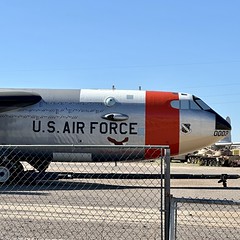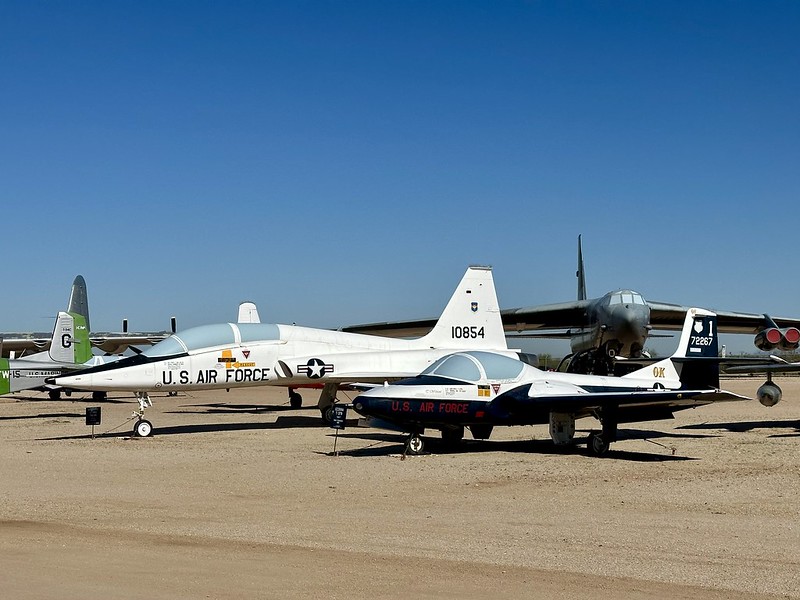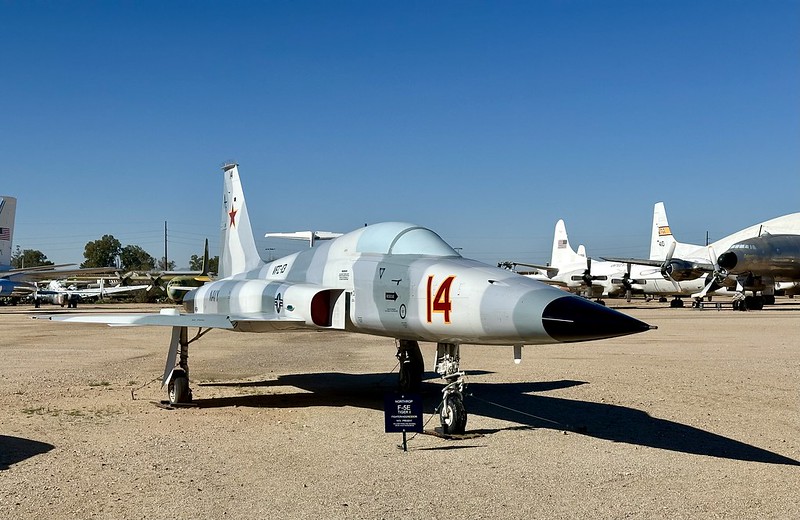 It must be spring, because I made the first of two annual treks to Pima Air & Space Museum today. I like to take advantage of the pleasant outdoor weather in early spring and late fall to walk around the grounds, check out what’s new and different from my last visit, and share photos with you here.
It must be spring, because I made the first of two annual treks to Pima Air & Space Museum today. I like to take advantage of the pleasant outdoor weather in early spring and late fall to walk around the grounds, check out what’s new and different from my last visit, and share photos with you here.
An old friend’s in town, so we met at the museum to catch up with one another. Al and I were stationed together in the Netherlands a few decades back; we had a good but all too short visit. I got to pretend I was a docent again and bore Al with trivia about a few planes, which was fun for me (if not for him). As for new and different, little had changed since my last visit to the museum. I didn’t let that deter me from taking photos, though.
Well, actually, I did see one new-to-me display, right inside the entrance: an Allison T56 turboprop. This is the engine that powers aircraft like the Lockheed C-130 Hercules and P-3 Orion.
The concept of a turboprop is simple enough: a jet turbine driving a propeller. What I hadn’t realized until seeing one laid out like a dissected frog in biology class is how simple the damn things actually are … correct me if I’m wrong, but this looks to me like a conventional turbojet engine connected by a driveshaft to a big-ass gearbox and propeller assembly. How about that?
 PASM has an Instagram account, where they recently posted a photo of an F-16 Viper wearing shiny new paint and markings. I expected to see it on display today, but it was nowhere in sight. Another Viper, this one with Arizona Air National Guard markings, is sitting behind the fence surrounding the restoration area, but it’s not the same aircraft.
PASM has an Instagram account, where they recently posted a photo of an F-16 Viper wearing shiny new paint and markings. I expected to see it on display today, but it was nowhere in sight. Another Viper, this one with Arizona Air National Guard markings, is sitting behind the fence surrounding the restoration area, but it’s not the same aircraft.
Through the fence I also spotted the German Marine F-104 Starfire and U.S. Air Force F-117 Nighthawk I included in my last PASM photoblog, along with two newly-acquired fighters awaiting restoration, an RAF Jaguar and a U.S. Navy F/A-18 Hornet. Sadly, these two are screened from clear view by other restoration projects. I’ll try to get photos of them on my next visit.
I probably posted photos of the following aircraft in previous photoblogs, but like I said, I’m not letting that deter me.
These are the U.S. Air Force advanced and primary jet trainers of my era, the Northrop T-38 Talon and Cessna T-37 Tweet. Tweets are long retired, replaced by T-6 Texan II turboprops, but Talons are still in use. They should be replaced by T-7 Redhawks by the end of the decade.
This is a British Gloster Meteor, the only Allied jet to see combat in WWII, this one in the markings of the Israeli Air Force’s 119 Squadron, for which it flew in the mid-1950s.
Update (3/26/24): a reader asked if I knew about Operation Tarnegol, in which an IAF Meteor night fighter like this one shot down an Egyptian Ilyushin Il-14 carrying high-ranking members of the Egyptian general staff. I didn’t and read the linked story with great interest. I note PASM’s Meteor is the correct night-fighter version and bears the same number as the Meteor used in the shootdown. I also note that PASM’s online description of this aircraft does not mention Operation Tarnegol, even though the restoration staff who painted this aircraft obviously knew the story. Interesting.
This is a fairly new exhibit, a Northrop F-5E Tiger II, a lightweight fighter developed for export, widely used by air forces around the world. A number of these aircraft were repurposed as aggressor aircraft to train U.S. Air Force, Navy, and Marine fighter pilots in adversary tactics. They’re about the size of a MiG-21, with similar (no, better) capabilities and performance, and you’ll get a real workout in a dogfight with one of these zippy little jets.
I’ve taken a particular interest in one long-term restoration project, the third B-52 ever built and currently the oldest one in existence, on display at PASM for many years but pulled off-line for repainting in May 2016 and still in the restoration compound, viewable only from a distance. Balls Three (named for its serial number, 0003), was one of two Edwards AFB B-52 motherships used to air-launch the X-15 rocket plane and other experimental aircraft, a real piece of history.
 Balls Three looks as if its restoration is finally complete. It’s been repaired and repainted, right down to the nose art and launch mission stencils on its side (visible if you click on the photo to enlarge it). Putting it back on display will involve moving several aircraft to clear a path, and I expect that’s the only remaining obstacle. I’m keeping my ear to the ground … if I learn the date they plan move it back onto bomber row I might make a special trip out to document it.
Balls Three looks as if its restoration is finally complete. It’s been repaired and repainted, right down to the nose art and launch mission stencils on its side (visible if you click on the photo to enlarge it). Putting it back on display will involve moving several aircraft to clear a path, and I expect that’s the only remaining obstacle. I’m keeping my ear to the ground … if I learn the date they plan move it back onto bomber row I might make a special trip out to document it.
The museum’s still recovering from Covid, judging by the number of visitors I encounter on my visits. When the pandemic hit, four years ago, PASM shut its doors for approximately six months, surviving on a small business PPP loan from the government. When it did reopen, it was with reduced hours, and needed another PPP loan to pay the staff.
PASM’s fully open again now, although still operating with what appears to be minimal staffing and only a few volunteers. My friend Al and I didn’t see a single docent or staff member on the grounds or in the hangars we toured this morning. I’m surprised no one has vandalized the exhibits — one of our volunteer responsibilities, back in pre-Covid days, was to keep an eye out for stuff like that. Today, visitors are pretty much on their own, but at least now they can rent portable devices which scan bar codes on display placards and play audio descriptions of individual aircraft and exhibits. These are new, but I didn’t rent one and can’t say how well they work. There are tram tours of the outdoor aircraft again, but the drivers are paid employees who narrate from a script — no war stories like the ones my colleagues and I once entertained visitors with.
This was visitor parking when I left around 10:30 a.m. Still plenty of empty slots. If you’re out this way, it’s a great time to visit the museum. You won’t have to fight a crowd!
As always, you can click on my photos to see them bigger on Flickr. Also as always, I took more photos than I shared here. You can click here to see them all.





Hard to believe how old the T-38 Talon is, yet I see and hear them screaming overhead every week in the skies over the Great Valley.
The derisive description for the lightweight, pretentiously named Freedom Fighter, the Talon’s little brother, was ‘air inferiority fighter’.
Cool looking Gloster Meteor in Israeli colors. The only WWII combat experience for it I’ve ever read about was shooting down Nazi V-1 Buzz Bombs. It took the Korean conflict to produce the first jet vs jet air combat.
With the coming of the F-35 to replace the A-10 Warthog the USAF is finally retiring the 1st tranche this year. So the Warthog air demo team is also folding its tents after this year and disbanding. Your last Arizona chances to see the show is at Luke AFB on the 23rd and 24th: or at Bullhead City, AZ, on April 6. But I’ll bet you don’t get to hear the mighty hippo fart sound of the 30mm Gatling gun being fired.
BTW not ‘pinpoint accurate’ as claimed by any means and responsible for lots of fatal ‘collateral damage’ in combat service, vibrations greatly increasing the CEP (Circular error probable) footprint.
I hope museums and the Davis Monthan boneyard keep the planes grounded. As effective as it once was, to fly it in Ukraine in modern warfare would be a quick ending. Too old, slow and vulnerable, titanium armor cockpit ‘bathtub’ and redundant airplane bits or not.
Tod recently posted…Headless CB Guitar Build: Day II, Attaching ‘Tailpiece’